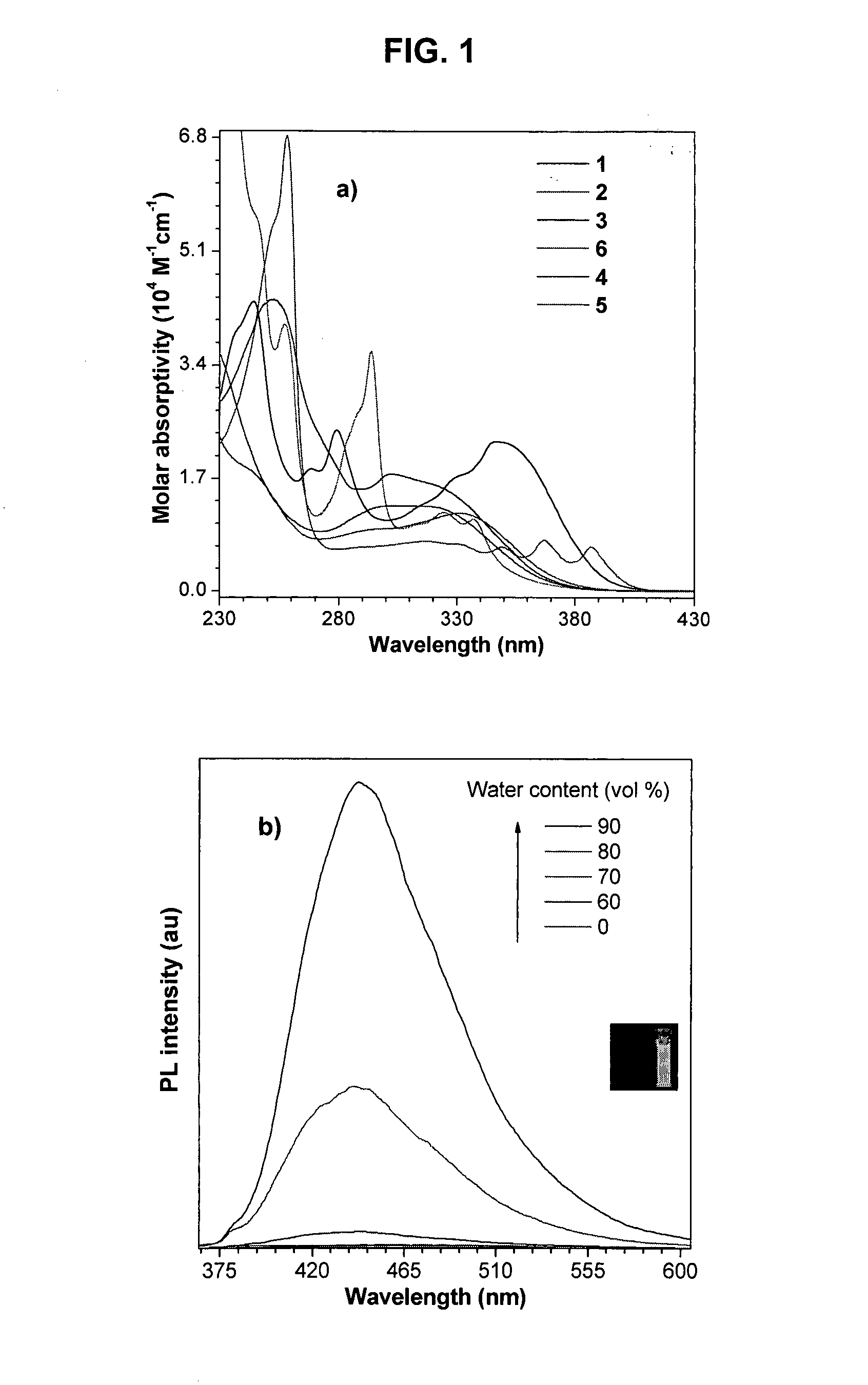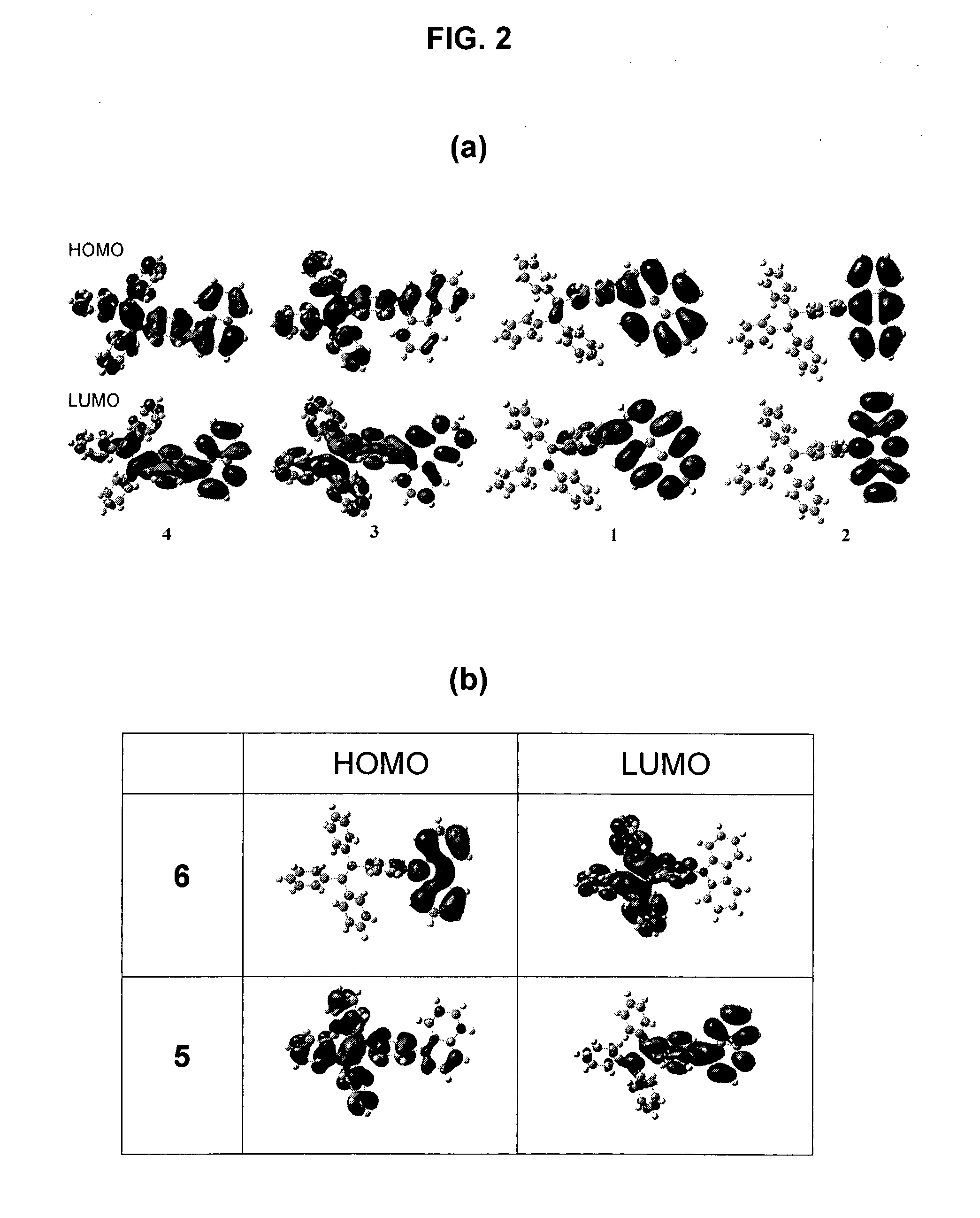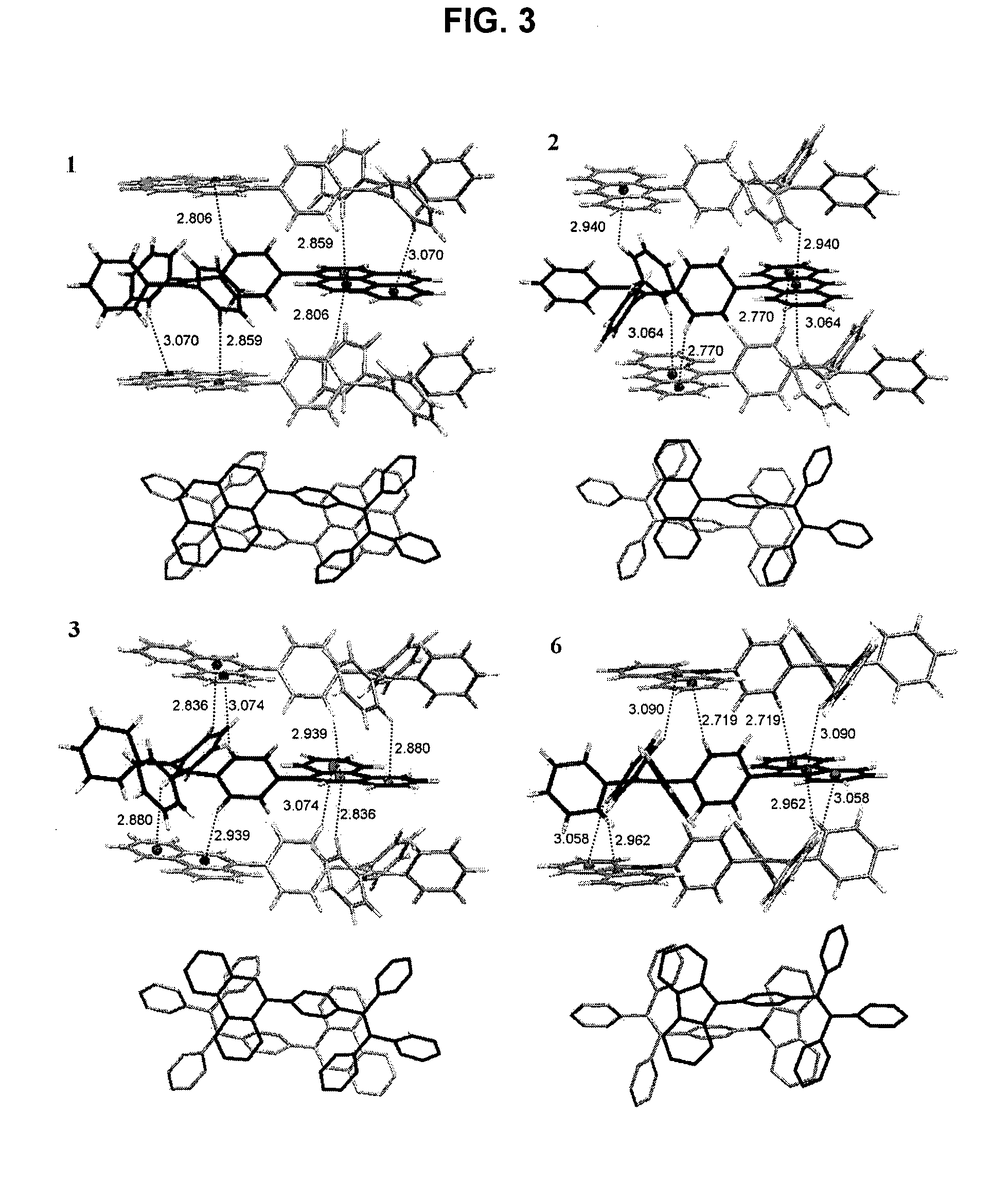Light emitting tetraphenylene derivatives, its method for preparation and light emitting device using the same derivatives
- Summary
- Abstract
- Description
- Claims
- Application Information
AI Technical Summary
Benefits of technology
Problems solved by technology
Method used
Image
Examples
example 1
[0152]
[0153]A mixture of 19 (1.0 mmol), 1-bromopyrene (1.1 mmol), Pd(PPh3)4 (0.05 mmol) and potassium carbonate (4.0 mmol) in 100 mL of toluene / ethanol / water (8 / 1 / 1 v / v / v) was heated to reflux for 24 h under nitrogen. After filtration and solvent evaporation, the residue was purified by silica-gel column chromatography using a hexane / dichloromethane or ethyl acetate mixture as eluent.
[0154]Characterization Data: White solid; yield 63%. m.p.: 303° C. 1H NMR (300 MHz, CD2Cl2), δ(TMS, ppm): 8.21-8.16 (m, 3H), 8.11-7.93 (m, 6H), 7.37 (d, 2H, J=8.7 Hz), 7.22-7.08 (m, 17). 13C NMR (75 MHz, CD2Cl2), δ(TMS, ppm): 144.5, 144.4, 144.3, 143.4, 142.1, 141.4, 139.8, 138.3, 132.2, 131.7, 131.2, 130.6, 129.1, 128.4, 128.2, 128.1, 128.0, 127.2, 126.7, 126.0, 125.7, 125.6, 125.4, 125.3. MS (MALDI-TOF): m / z 532.2513 (M+, calcd 532.2191). Anal. Calcd for C42H28: C, 94.70; H, 5.30. Found: C, 94.64; H, 5.29.
example 2
[0155]
[0156]A mixture of 19 (1.0 mmol), 9-bromoanthracene (1.1 mmol), Pd(PPh3)4 (0.05 mmol), and potassium carbonate (4.0 mmol) in 100 mL of toluene / ethanol / water (8 / 1 / 1 v / v / v) was heated to reflux for 24 h under nitrogen. After filtration and solvent evaporation, the residue was purified by silica-gel column chromatography using hexane / dichloromethane or ethyl acetate mixture as eluent.
[0157]Characterization Data: White solid; yield 69%. m.p.: 301° C. 1H NMR (300 to MHz, CD2Cl2), δ(TMS, ppm): 8.45 (s, 1H), 8.03 (d, 2H, J=8.4 Hz), 7.59 (d, 2H, J=8.7 Hz), 7.48-7.43 (m, 2H), 7.38-7.33 (m, 2H), 7.25-7.13 (M, 19H). 13C NMR (75 MHz, CD2Cl2), δ(TMS, ppm): 144.6, 144.4, 144.2, 143.9, 142.3, 137.6, 137.5, 132.2, 132.1, 132.03, 132.00, 131.9, 131.2, 130.8, 129.0, 128.51, 128.45, 128.4, 127.4, 127.3, 127.1, 126.0, 125.9. MS (MALDI-TOF): m / z 508.2436 (M+, calcd 508.2191). Anal. Calcd for C40H28: C, 94.45; H, 5.55. Found: C, 94.14; H, 5.57.
example 3
[0158]
[0159]A mixture of 19 (1.0 mmol), 9-bromophenanthrene (1.1 mmol), Pd(PPh3)4 (0.05 mmol), and potassium carbonate (4.0 mmol) in 100 mL of toluene / ethanol / water (8 / 1 / 1 v / v / v) was heated to reflux for 24 h under nitrogen. After filtration and solvent evaporation, the residue was purified by silica-gel column chromatography using hexane / dichloromethane or ethyl acetate mixture as eluent.
[0160]Characterization Data: White solid; yield 80%. m.p.: 200° C. 1H NMR (300 MHz, CD2Cl2), δ(TMS, ppm): 8.76 (d, 1H, J=7.8 Hz), 8.71 (d, 1H, J=8.4 Hz), 7.90-7.83 (m, 2H), 7.69-7.51 (m, 5H), 7.29 (d, 2H, J=7.8 Hz), 7.20-7.08 (m, 17H). 13C NMR (75 MHz, CD2Cl2), δ(TMS, ppm): 144.5, 144.4, 143.7, 142.1, 141.5, 139.5, 139.2, 132.3, 132.1, 132.0, 131.9, 131.7, 131.3, 130.6, 130.1, 129.3, 128.5, 128.4, 128.0, 127.6, 127.5, 127.3, 127.2, 123.6, 123.2. MS (MALDI-TOF): m / z 508.2397 (M+, calcd 508.2191). Anal. Calcd for C40H28: C, 94.45; H, 5.55. Found: C, 94.06; H, 5.57.
PUM
| Property | Measurement | Unit |
|---|---|---|
| Mass | aaaaa | aaaaa |
| Fraction | aaaaa | aaaaa |
| Fraction | aaaaa | aaaaa |
Abstract
Description
Claims
Application Information
 Login to View More
Login to View More - R&D
- Intellectual Property
- Life Sciences
- Materials
- Tech Scout
- Unparalleled Data Quality
- Higher Quality Content
- 60% Fewer Hallucinations
Browse by: Latest US Patents, China's latest patents, Technical Efficacy Thesaurus, Application Domain, Technology Topic, Popular Technical Reports.
© 2025 PatSnap. All rights reserved.Legal|Privacy policy|Modern Slavery Act Transparency Statement|Sitemap|About US| Contact US: help@patsnap.com



